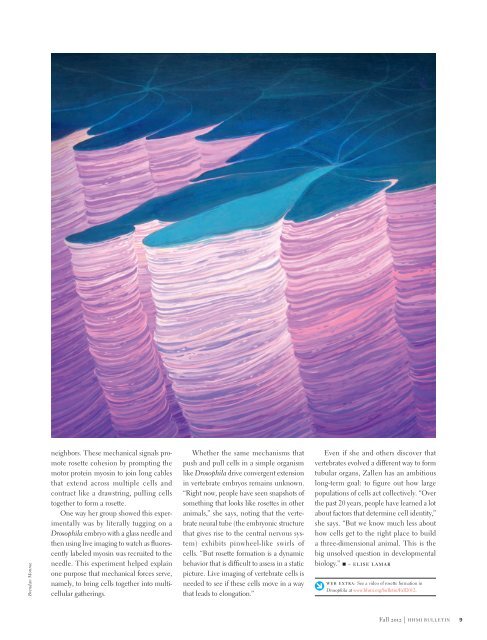Download PDF - Howard Hughes Medical Institute
Download PDF - Howard Hughes Medical Institute
Download PDF - Howard Hughes Medical Institute
Create successful ePaper yourself
Turn your PDF publications into a flip-book with our unique Google optimized e-Paper software.
Brendan Monroe<br />
neighbors. These mechanical signals promote<br />
rosette cohesion by prompting the<br />
motor protein myosin to join long cables<br />
that extend across multiple cells and<br />
contract like a drawstring, pulling cells<br />
together to form a rosette.<br />
One way her group showed this experimentally<br />
was by literally tugging on a<br />
Drosophila embryo with a glass needle and<br />
then using live imaging to watch as fluorescently<br />
labeled myosin was recruited to the<br />
needle. This experiment helped explain<br />
one purpose that mechanical forces serve,<br />
namely, to bring cells together into multicellular<br />
gatherings.<br />
Whether the same mechanisms that<br />
push and pull cells in a simple organism<br />
like Drosophila drive convergent extension<br />
in vertebrate embryos remains unknown.<br />
“Right now, people have seen snapshots of<br />
something that looks like rosettes in other<br />
animals,” she says, noting that the vertebrate<br />
neural tube (the embryonic structure<br />
that gives rise to the central nervous system)<br />
exhibits pinwheel-like swirls of<br />
cells. “But rosette formation is a dynamic<br />
behavior that is difficult to assess in a static<br />
picture. Live imaging of vertebrate cells is<br />
needed to see if these cells move in a way<br />
that leads to elongation.”<br />
Even if she and others discover that<br />
vertebrates evolved a different way to form<br />
tubular organs, Zallen has an ambitious<br />
long-term goal: to figure out how large<br />
populations of cells act collectively. “Over<br />
the past 20 years, people have learned a lot<br />
about factors that determine cell identity,”<br />
she says. “But we know much less about<br />
how cells get to the right place to build<br />
a three-dimensional animal. This is the<br />
big unsolved question in developmental<br />
biology.” W – elise lamar<br />
web extra: See a video of rosette formation in<br />
Drosophila at www.hhmi.org/bulletin/Fall2012.<br />
Fall 2o12 | h h m i b u l l e t i n<br />
9
















